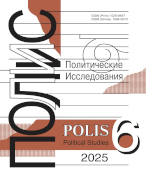The Foundations of European Integration
DOI: 10.17976/jpps/2002.04.10
Griffiths R.T. The Foundations of European Integration . – Polis. Political Studies. 2002. No. 4. https://doi.org/10.17976/jpps/2002.04.10
In an application for European Union membership, according to the viewpoint developed in the article, Russia could in actual reality contemplate an early adhesion to some policy areas and pledge to join the rest at a later date. True, it has never been done before, the author stresses, but neither, he continues, had the joining of two mortal enemies (France and Germany) in a supranational community: European Coal and Steel Community (ECSC) founded in 1951. It was the famous Schuman Plan announced in the French Foreign Minister Schuman's radio broadcast of the 9th of May, 1950, that laid the foundation of the ECSC, and the latter, in its turn, laid the foundation of postwar European integration from which Russia has for many years been excluded and has excluded herself. However, the author makes an attempt to unravel the reasons why that particular policy option was chosen to resolve the problems faced over fifty years ago, and why it could fulfill the same needs today. The author retraces both prehistory and history of the conceiving of the Plan. It is demonstrated in the article, why the Plan could not have been worked out earlier and why, at the same time, even a few days' delay would have made its announcement senseless.
See also:
Malkov S.Yu., Korotayev A.V., Isayev L.M., Kuzminova Ye.V.,
On methods of estimating current condition and of forecasting social instability: attempted quantitative analysis of the events of the Arab spring. – Polis. Political Studies. 2013. No4
Zamyatin D.N.,
Geopolitics: Major Problems and Results of Development in the 20th Century. – Polis. Political Studies. 2001. No6
Safonov M.V.,
Modern Approaches to the Study of International Institutions (With Studies of the “Big Eight” as Instance). – Polis. Political Studies. 2003. No3
Nisnevich Yu.A., Rozhich P.,
Lustration as instrument of counteracting corruption. – Polis. Political Studies. 2014. No1
Lyublinsky V.V.,
The Political Dimension of Social Inequality and Poverty (Comparative Experience). – Polis. Political Studies. 2015. No5




.jpg)






 print
print
.jpg)
.jpg)